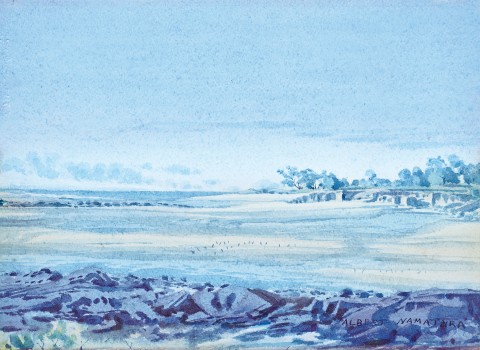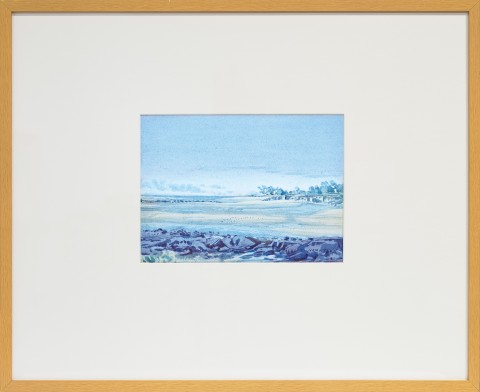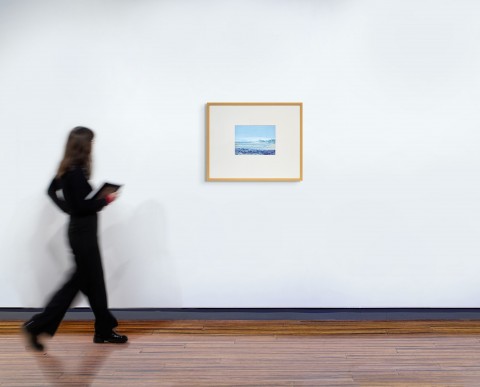(1902 - 1959)
Albert Namatjira
Darwin, 1950
watercolour on paper on cardboard
Norman Neil McLean, Darwin, acquired on a visit to central Australia in the 1950s
Thence by descent
Private collection, Queensland
on long term loan to the National Gallery of Australia, Canberra until 2025
Arafura Sea at Darwin, 1950, watercolour on paper, 34.0 x 37.0 cm, private collection, sold Deutscher and Hackett, Melbourne, 26 March 2025, lot 10
In July 1950, Albert Namatjira departed central Australia for the first time, traveling to Darwin on a personal mission to gain approval to acquire a pastoral lease north-west of the Haast’s range where he intended his family to make a living grazing cattle. Although ultimately unsuccessful as the government authorities denied his request, the trip resulted in the creation of a small number of rare and important seascapes of the Darwin coastline that was unlike any previous work produced by the artist.
Arriving on 19 July in Darwin, he thought the place the biggest in the world; notably Namatjira was yet to embark on his 1954 journey to the southern capitals. Although Namatjira had no intention to paint on the trip, this soon changed after a visit to Rapid Creek beach, and with the Arafura Sea stretching out beyond, he vowed to return to record these watery scenes. The first attempt he destroyed feeling it was an inferior work, yet Namatjira persevered and completed four or five seascapes, including our work. Darwin, 1950, is a sparse rendering of Rapid Creek beach in both subject and palette. Painted at low tide with the Arafura Sea stretching to the distant horizon, the work features the brightness of the morning light washing across the stark white beach in the foreground, with low coastal mangroves and hardy salt-resistant Melaleuca and Casuarina trees filling the middle ground promontory and the blue/green Arafura sea in the distance.
Two watercolours painted during this trip were illustrated in the September 1950 edition of The Australian Women’s Weekly magazine – namely Bloodwood trees at Rapid Creek, 1950, and Arafura Sea at Darwin, 1950 (sold at Deutscher and Hackett on 26 March 2025) which was illustrated in colour. The accompanying article written by Robert Freeden under the banner ‘NAMATJIRA PAINTS HIS FIRST SEASCAPE’, noted that ‘For Albert Namatjira, the aboriginal artist, to paint his first seascape took courage of a sort that white Australians might find it difficult to understand. When Namatjira visited Darwin recently he went into what was for him, a foreign country… But nobody, not even Namatjira, realised what his reaction to the sea would be. He saw it first in the morning light, the glittering blue-green Arafura Sea. For a whole day Namatjira stared at the sea. Next morning, he completed his first seascape. It was subdued, timid. I realised Namatjira was afraid of Darwin. For two days he painted no more. But he kept coming back to look at the sea. One day without word to anyone, he walked along the beach and painted the two pictures in this issue.’1
The art of Albert Namatjira is now understood to have inspired his own and subsequent generations of Aboriginal people and artists across Australia. As Brenda Croft argues, the artist’s gift to indigenous and non-indigenous people is ‘more than the sum parts of watercolour paints on paper. It is an essence that resides in the strength of Namatjira’s work – his courage, his sorrow, his spirituality… where the enduring influence of this one man upon the entire indigenous arts and culture industry continues to be felt.’2
1. Freeden, R., ‘Namatjira Paints His First Seascape’, The Australian Women’s Weekly, Sydney, 16 September 1950, p. 36
2. Croft, B., ‘Albert’s Gift’ in French, A., Seeing the Centre: The Art of Albert Namatjira, 1902 – 1959, National Gallery of Australia, Canberra, 2002, p. 148
CRISPIN GUTTERIDGE


